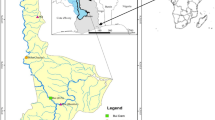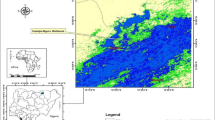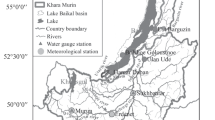Abstract
The headwater region of the upper Blue Nile is the main source of the Nile water for the three Eastern Nile countries, namely Ethiopia, Sudan, and Egypt. Climate-related studies for the region is thus paramount. However, previous studies for the region used non-homogenous data, and did not remove all the significant autocorrelations in trend analysis. Therefore, this study analyzed the trend using gap-filled and homogenized meteorological data over the period 1980 − 2017. Using the non-parametric Mann–Kendall test adjusted by effective sample size, the influence of all significant positive and negative autocorrelations on the trend was removed. Sen’s slope was used to determine the magnitude of trends. The tests were applied to minimum and maximum temperatures, mean temperature, diurnal temperature range (DTR), and total precipitation as well as seasonal and annual extreme climate indices. In general, the climate in the study region has become wetter and warmer. As for extreme temperature, the hot ends of the daily temperature distribution have altered more rapidly than the cold ends. Accordingly, the DTR exhibited a consistent increasing trend across the stations. The rainfall showed increases in maximum 1 − day precipitation amount, maximum 5 − day precipitation amount, number of heavy precipitation days, total annual rainfall, and extremely wet days. As trend magnitudes of the homogenized series differed from those of the original series, the results that emerged from the previous hydroclimate-related studies for the region using non-homogenized data should be revised. This study has significant implications for water use efficiency and adaptation to climate risk in the three riparian countries, given the recently commenced water resources projects.





Similar content being viewed by others
Data availability
Not applicable.
Code availability
Not applicable.
References
Aguilar AE, Barry AA, Brunet M, Ekang L, Fernandes A, Massoukina M, Mbah J, Mhanda A, do Nascimento DJ, Peterson TC, ThambaUmba O, Tomou M, Zhang X (2009) Changes in temperature and precipitation extremes in western central Africa, Guinea Conakry, and Zimbabwe, 1955–2006. J Geophys Res 114:DO2115. https://doi.org/10.1029/2008JD011010
Alexander LV, Zhang X, Peterson TC, Caesar J, Gleason B, Klein Tank AMG, Haylock M, Collins D, Trewin B, Rahimzadeh F, Tagipour A, Rupa Kumar K, Revadekar J, Griffiths G, Vincent L, Stephenson DB, Burn J, Aguilar E, Brunet M, Taylor M, New M, Zhai P, Rusticucci M, Vazquez-Aguirre JL (2006) Global observed changes in daily climate extremes of temperature and precipitation. J Geophys Res 111:D05109
Asfaw A, Simane B, Hassen A, Bantider A (2018) Variability and time series trend analysis of rainfall and temperature in northeastern Ethiopia: a case study in Woleka sub-basin. Weather and Climate Extremes 19:29–41
Bayley GV, Hammersley JM (1946) The “effective” number of independent observations in an autocorrelated time series. J R Stat Soc B8:184–197
Berhane A, Hadgu G, Worku W, Abrha B (2020) Trends in extreme temperature and rainfall indices in the semi-arid areas of Western Tigray. Ethiopia Environ Systems Res 9(1):1–20
Brown SJ, Caesar J, Ferro CAT (2008) Global changes in extreme daily temperature since 1950. J Geophys Res 113:D05115. https://doi.org/10.1029/2006JD008091
Caesar J, Alexander LV, Trewin B, Tsering K, Sorany L, Vuniyayawa V, Keosavang N, Shimana A, Htay MM, Karmacharya J, Jayasinghearachchi DA, Sakkamart J, Soares E, Hung LT, Thuong LT, Hue CT, Dung NTT, Hung PV, Cuong HD, Cuong NM, Sirabaha S (2011) Changes in temperature and precipitation extremes over the Indo-Pacific region from 1971–2005. Int J Climatol 31:791–801
Cheung WH, Senay GB, Singh A (2008) Trends and spatial distribution of annual and seasonal rainfall in Ethiopia. Int J Climatol 28:1723–1734
Christy JR, Norris WB, McNider RT (2009) Surface temperature variations in east Africa and possible causes. J Climate 22:3342–3356
Collins JM (2011) Temperature Variability over Africa. J Climate 24:3649–3666. https://doi.org/10.1175/2011JCLI3753.1
Conway D, Mould C, Bewket W (2004) Over one century of rainfall and temperature in Addis Ababa, Ethiopia. Int J Climatol 24:77–91. https://doi.org/10.1002/joc.989
Das HP, Adamenko TI, Anaman KA, Gommes RG, Johnson G (2003). Agrometeorology related to extreme events. World Meteorological Organization, Technical Note No. 201.
Degefu MA, Bewket W (2014) Variability and trends in rainfall amount and extreme event indices in the Omo-Ghibe River Basin, Ethiopia. Reg Environ Change 14:799–810. https://doi.org/10.1007/s10113-013-0538-z
Degefu MA, Rowell DP, Bewket W (2016) Teleconnections between Ethiopian rainfall variability and global SSTs: observations and methods for model evaluation. Meteorol Atmos Phys 129(2):173–186. https://doi.org/10.1007/s00703-016-0466-9
Diro GT, Grimes DIF, Black E (2011) Teleconnections between Ethiopian summer rainfall and sea surface temperature: part I-observation and modelling. Clim Dyn 37(1):103–119. https://doi.org/10.1007/s00382-010-0837-8
Donat MG, Alexander LV, Yang H, Durre I, Vose R, Caesar J (2013) Global land-based datasets for monitoring climatic extremes. Bull Am Meteorol Soc 96:997–1006. https://doi.org/10.1175/BAMS-D-12-00109.1
Easterling DR, Alexander L, Mokssit A, Detemmerman V (2003) CCI/CLIVAR workshop to develop priority climate indices. Bull Amer Meteor Soc 84:1403–1407
Elagib NA (2010) Trends in intra- and inter-annual temperature variabilities across Sudan. Ambio 39:413–429. https://doi.org/10.1007/s13280-010-0042-3
Elagib NA (2011) Evolution of urban heat island in Khartoum. Int J Climatol 31(9):1377–1388. https://doi.org/10.1002/joc.2159
Elagib NA, Abdu ASA (2010) Development of temperatures in the Kingdom of Bahrain from 1947 to 2005. Theor Appl Climatol 101:269–279. https://doi.org/10.1007/s00704-009-0205-y
Elagib NA, Mansell MG (2000) Recent trends and anomalies in mean seasonal and annual temperatures over Sudan. J Arid Environ 45(3):263–288
Elagib NA, Saad SAG, Basheer M, Rahma AE, Gore EDL (2021) Exploring the urban water-energy-food nexus under environmental hazards within the Nile. Stoch Environ Res Risk Assess 35:21–41
Funk C, Nicholson SE, Landsfeld M, Klotter D, Peterson P, Harrison L (2015) The Centennial Trends Greater Horn of Africa precipitation dataset. Scientific Data 2:150050. https://doi.org/10.1038/sdata.2015.50
Gebrechorkos SH, Hülsmann S, Bernhofer C (2019). Long-term trends in rainfall and temperature using high-resolution climate datasets in East Africa. Scientific Reports, 9(1). doi:https://doi.org/10.1038/s41598-019-47933-8
Gebrechorkos SH, Hülsmann S, Bernhofer C (2018) Changes in temperature and precipitation extremes in Ethiopia, Kenya, and Tanzania. Int J Climatol 39(1):18–30. https://doi.org/10.1002/joc.5777
Gebremicael TG, Mohamed YA, Betrie GD, van der Zaag P, Teferi E (2013) Trend analysis of runoff and sediment fluxes in the Upper Blue Nile basin: a combined analysis of statistical tests, physically-based models and landuse maps. J Hydrol 482:57–68
Gleixner S, Keenlyside N, Viste E, Korecha D (2016) The El Niño effect on Ethiopian summer rainfall. Clim Dyn 49(5–6):1865–1883. https://doi.org/10.1007/s00382-016-3421-z
Gummadi S, Rao KPC, Seid J, Legesse G, Kadiyala MDM, Takele R, Amede T, Anthony Whitbread A (2017) Spatio-temporal variability and trends of precipitation and extreme rainfall events in Ethiopia in 1980–2010. Theor Appl Climatol 134:1315–1328. https://doi.org/10.1007/s00704-017-2340-1
Hamed KH (2008) Trend detection in hydrologic data: the Mann-Kendall trend test under the scaling hypothesis. J Hydrol 349(3–4):350–363
Hatfield JL, Prueger JH (2015) Temperature extremes: effect on plant growth and development. Weather Clim Extremes 10:4–10
Hegerl GC, Brönnimann S, Cowan T, Friedman AR, Hawkins E, Iles C, Müller W, Schurer A, Undorf S (2019) Causes of climate change over the historical record. Environ Res Lett 14:123006. https://doi.org/10.1088/1748-9326/ab4557
Hulme M, Doherty R, Ngara T, New M, Lister D (2001) African climate change: 1900–2100. Climate Res 17:145–168
IPCC (2012). Managing the Risks of Extreme Events and Disasters to Advance Climate Change Adaptation: A Special Report of Working Groups I and II of the Intergovernmental Panel on Climate Change. http://ipcc-wg2.gov/SREX/report/full-report/.
Jaweso D, Abate B, Bauwe A, Lennartz B (2019) Hydro-meteorological trends in the upper Omo-Ghibe river basin. Ethiopia Water 11(9):1951
Karl TR, Knight RW, Gallo KP, Peterson TC (1993) A new perspective on recent global warming: asymmetric trends of daily maximum and minimum temperature. Bull Amer Meteor Soc 74(6):1007–1023
Katz RW, Brown BG (1992) Extreme events in a changing climate: variability is more important than averages. Clim Change 21(3):289–302
Kendall MG (1975) Rank Correlation Methods. Charles Griffin, London
King’uyu SM, Ogallo LA, Anyamba EK, (2000) Recent trends on minimum and maximum surface temperatures over eastern Africa. J Climate 13:2876–2886
Kruger AC, Shongwe S (2004) Temperature trends in South Africa: 1960–2003. Int J Climatol 24:1929–1945. https://doi.org/10.1002/joc.1096
Kruger AC, Sekele SS (2013) Trends in extreme temperature indices in South Africa: 1962–2009. Int J Climatol 33(3):661–676
Lionello P, Scarascia L (2020) The relation of climate extremes with global warming in the Mediterranean region and its north versus south contrast. Reg Environ Change 20:31. https://doi.org/10.1007/s10113-020-01610-z
Maidment RI, Allan RP, Black E (2015) Recent observed and simulated changes in precipitation over Africa. Geophys Res Lett 42:8155–8164. https://doi.org/10.1002/2015GL065765
Manikandan N, Das DK, Mukherjee J, Sehgal VK, Krishnan P (2018) Extreme temperature and rainfall events in National Capital Region of India (New Delhi) in the recent decades and its possible impacts. Theor Appl Climatol. https://doi.org/10.1007/s00704-018-2652-9
Mann HB (1945) Nonparametric tests against trend. Econometrica 13:245–259
Meehl GA, Tebaldi C, Walton G, Easterling D, McDaniel L (2009) Relative increase of record high maximum temperatures compared with record low minimum temperatures in the U.S. Geophys Res Lett 36:L23701. https://doi.org/10.1029/2009GL040736
Mengistu D, Bewket W, Lal R (2014) Recent spatiotemporal temperature and rainfall variability and trends over the upper Blue Nile River Basin, Ethiopia. Int J Climatol 34:2278–2292
Meshram SG, Kahya E, Meshram C, Ghorbani MA, Ambade B, Mirabbasi R (2020) Long-term temperature trend analysis associated with agriculture crops. Theor Appl Climatol 140:1139–1159. https://doi.org/10.1007/s00704-020-03137-z
Mpelasoka F, Awange JL, Zerihun A (2018) Influence of coupled ocean-atmosphere phenomena on the Greater Horn of Africa droughts and their implications. Sci Total Environ 610–611:691–702
Nashwan MS, Shahid S (2019) Spatial distribution of unidirectional trends in climate and weather extremes in Nile river basin. Theor Appl Climatol 137:1181–1199. https://doi.org/10.1007/s00704-018-2664-5
New M, Hewitson B, Stephenson DA, Tsiga A, Kruger A, Manhique A, Gomez B, Coelho CAS, Masisi DN, Kululanga E, Mbambalala E, Adesina F, Saleh H, Kanyanga J, Adosi J, Bulane L, Fortunata L, Mdoka ML, Lajoie R (2006) Evidence of trends in daily climate extremes over Southern and West Africa. J Geophys Res 111:D14102. https://doi.org/10.1029/2005JD006289
NMA (National Meteorological Agency) (1996) Climatic and agro-climatic resources of Ethiopia. NMSA Meteorological Research Report Series. V1, No. 1, Addis Ababa, 137p
Omondi P, Ogallo LA, Anyah RO, Muthama JM, Ininda J (2013) Linkages between global sea surface temperatures and decadal rainfall variability over Eastern Africa region. Int J Climatol 33(8):2082–2104. https://doi.org/10.1002/joc.3578
Perera ATD, Nik VM, Chen D, Scartezzini J-L, Hong T (2020) Quantifying the impacts of climate change and extreme climate events on energy systems. Nat Energy 5:150–159. https://doi.org/10.1038/s41560-020-0558-0
Rai P, Choudhary A, Dimri AP (2019) Future precipitation extremes over India from the CORDEX-South Asia experiments. Theor Appl Climatol. https://doi.org/10.1007/s00704-019-02784-1
Rey J, Rohat G, Perroud M, Goyette S, Kasparian J (2020). Shifting velocity of temperature extremes under climate change. Environ. Res. Lett. 15(3) 034027.
Saddique N, Khaliq A, Bernhofer C (2020) Trends in temperature and precipitation extremes in historical (1961–1990) and projected (2061–2090) periods in a data scarce mountain basin, northern Pakistan. Stoch Environ Res Risk Assess 34:1441–1455
Seleshi Y, Zanke U (2004) Recent changes in rainfall and rainy days in Ethiopia. Int J Climatol 24:973–983
Sen PK (1968) Estimates of the regression coefficient based on Kendall’s tau. J Amer Statist Assoc 63:1379–1389
Shang H, Yan J, Gebremichael M, Ayalew SM (2010) Trend analysis of extreme precipitation in the northwestern Highlands of Ethiopia with a case study of Debre Markos. Hydrol Earth Syst Sci 7:8587–8605. https://doi.org/10.5194/hess-15-1937-2011
Shawul AA, Chakma S (2020) Trend of extreme precipitation indices and analysis of long-term climate variability in the Upper Awash basin, Ethiopia. Theor Appl Climatol 140:635–652. https://doi.org/10.1007/s00704-020-03112-8
Sulieman HM, Elagib NA (2012) Implications of climate, land-use and land-cover changes for pastoralism in Eastern Sudan. J Arid Environ 85:132–141. https://doi.org/10.1016/j.jaridenv.2012.05.001
Sun W, Mu X, Song X, Wu D, Cheng A, Qiu B (2016) Changes in extreme temperature and precipitation events in the Loess Plateau (China) during 1960–2013 under global warming. Atmos Res 168:33–48
Szentimrey T (2011). Manual of Homogenization Software MASHv3.03. Hungarian Meteorological Service, Budapest, Hungary.
Tabari H, Taye MT, Willems P (2015) Statistical assessment of precipitation trends in the upper Blue Nile River basin. Stoch Env Res Risk A 29(7):1751–1761
Teferi E, Abraha H (2017). Urban heat island effect of Addis Ababa city: implications of urban green spaces for climate change adaptation. In: Leal Filho W, Belay S, Kalangu J, Menas W, Munishi P, Musiyiwa K (eds) Climate Change Adaptation in Africa. Climate Change Management. Springer, Cham. https://doi.org/10.1007/978-3-319-49520-0_33.
Tekleab S, Mohamed Y, Uhlenbrook S (2013) Hydro-climatic trends in the Abay/Upper Blue Nile basin, Ethiopia. Hydrology, land-use and climate in the Nile Basin: recent modelling experiences. Phys Chem Earth Parts a/b/c 61–62:32–42
Tesfamariam BG, Gessesse B, Melgani F (2019) Characterizing the spatiotemporal distribution of meteorological drought as a response to climate variability: the case of rift valley lakes basin of Ethiopia. Weather and Climate Extremes 26:100237. https://doi.org/10.1016/j.wace.2019.100237
Trewin B, Vermont H (2010) Changes in the frequency of record temperatures in Australia, 1957–2009. Austr Meteor Oceanogr J 60:113–119
van der Walt A, Fitchett JM (2020) Trend analysis of cold extremes in South Africa: 1960–2016. Int J Climatol 41(3):2060–2081. https://doi.org/10.1002/joc.6947
Viste E, Korecha D, Sorteberg A (2013) Recent drought and precipitation tendencies in Ethiopia. Theor Appl Climatol 112(3–4):535–551. https://doi.org/10.1007/s00704-012-0746-3
von Storch H (1999). Misuses of statistical analysis in climate research. In: von Storch H., Navarra A. (eds) Analysis of Climate Variability. Springer, Berlin, Heidelberg. https://doi.org/10.1007/978-3-662-03744-7_2
Wang F, Zhang C, Peng Y, Zhou H (2014) Diurnal temperature range variation and its causes in a semiarid region from 1957 to 2006. Int J Climatol 34(2):343–354. https://doi.org/10.1002/joc.3690
WMO (World Meteorological Organization) (2009) Guidelines on: analysis of extremes in a changing climate in support of informed decisions for adaptation. Climate Data and Monitoring WCDMP-No. 72. Geneva, Switzerland
Woldesenbet TA, Elagib NA, Ribbe L, Heinrich J (2017a) Hydrological responses to land use/cover changes in the source region of the Upper Blue Nile Basin. Ethiopia Sci Total Environ 575:724–741
Woldesenbet TA, Elagib NA, Ribbe L, Heinrich J (2017b) Gap-filling and homogenization of climatological datasets in the headwater region of the Upper Blue Nile Basin, Ethiopia. Int J Climatol 37:2122–2140
Worku T, Khare D, Tripathi SK (2019) Spatiotemporal trend analysis of rainfall and temperature, and its implications for crop production. J Water Clim Chang 10(4):799–817
Yue S, Pilon P, Phinney B, Cavadias G (2002) The influence of autocorrelation on the ability to detect trend in hydrological series. Hydrol Process 16:1807–1829. https://doi.org/10.1002/hyp.1095
Yue S, Wang CY (2004) The Mann-Kendall test modified by effective sample size to detect trend in serially correlated hydrological series. Water Resour Manag 18(3):201–218
Zhang L, Ren GY, Ren YY, Zhang AY, Chu ZY, Zhou YQ (2014) Effect of data homogenization on estimate of temperature trend: a case of Huairou station in Beijing Municipality. Theor Appl Climatol 115(3):365–373. https://doi.org/10.1007/s00704-013-0894-0
Zuo Q, Song Y, Wang H, Li J, Han C (2021) Spatial variations of extreme precipitation events and attribution analysis in the main water resource area of the Belt and Road Initiative. Theor Appl Climatol 144:535–554
Acknowledgements
Part of this study was carried out with the financial support of the Federal Ministry of Education and Research (BMBF) through the International Postgraduate Study in Water Technology Program (IPSWaT). The authors would like to express their gratitude to the Ethiopian National Meteorological Agency (NMA) for providing the meteorological data. The authors appreciate the support provided by Prof. Lars Ribbe and Prof. Jürgen Heinrich to a preliminary version of the work.
Author information
Authors and Affiliations
Contributions
Tekalegn Ayele Woldesenbet: conceptualization, methodology, formal analysis, and writing—original draft. Nadir Ahmed Elagib: methodology and writing—review and editing.
Corresponding author
Ethics declarations
Ethics approval
For this type of study, formal consent is not required.
Consent to participate
Not applicable.
Consent for publication
Not applicable.
Competing interests
The authors declare no competing interests.
Additional information
Publisher's note
Springer Nature remains neutral with regard to jurisdictional claims in published maps and institutional affiliations.
Supplementary Information
Below is the link to the electronic supplementary material.
Rights and permissions
About this article
Cite this article
Woldesenbet, T.A., Elagib, N.A. Analysis of climatic trends in the upper Blue Nile basin based on homogenized data. Theor Appl Climatol 146, 767–780 (2021). https://doi.org/10.1007/s00704-021-03767-x
Received:
Accepted:
Published:
Issue Date:
DOI: https://doi.org/10.1007/s00704-021-03767-x




